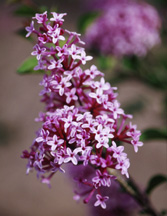 |
| © Bob Lollo |
Lilacs (Syringa sp.) are a large group of decorative shrubs and trees brought to the United States as early as 1700. Since then, the lovely flowers of common lilacs have earned them such popularity in this country that hundreds of hybrids, bred in France, are now available. They offer sturdier flowers and more flowers per stem along with the traditional lilac fragrance. Properly cared for, lilac shrubs may live for over 30 years.
Common lilac hybrids can handle considerable cold. They thrive north into northern New York State and along the coastal areas well into New England (Zone 4). They will do fine where average annual minimum temperatures do not fall below -20°F to -10° F. They will survive in areas in New England where temperatures dip to -20°F if they are protected. Common lilacs are not found in Florida and the deep south because areas below zone 7 are not cold enough to provide lilacs with the period of chilling they require. An exception to this is ‘Blue Skies’ which does not require the chilling and does well nationwide.
 |
| © Bailey Nursery |
| 'Prince Charming' Lilac |
Size: Common lilac shrubs grow from 10 to 20 feet high. Although they spread 4 to 8 feet, they can be kept more manageable by pruning. Smaller hybrids such as Meyer or Dwarf Korean lilac mature at only about 4 feet.
Foliage: Lilacs are deciduous, losing their leaves every fall. Lilac leaves are smooth dark green above, grayish below, and are oval or heart-shaped. From 2 to 6 inches long and 1 to 2 inches wide, they are arranged opposite each other on the stems. Common lilac shrubs are typically multi-stemmed, and have a tendency to produce suckers. These thin, weak leafed stems grow out along the main stems of the shrub, adding foliage, but never bearing blossoms.
Flowers : Lilac blooms are made up of many tiny trumpet-shaped florets, 5/16 inch long. They are clustered in tubular sprays that are from 4 to 6 inches long. Typically blooms appear in late April or early May, persisting for 2 to 3 weeks. They are very fragrant, although the later the bloom time, the weaker its fragrance is likely to be. Common lilac blooms are pale violet and shades of blue, pink to magenta, and white. Some varieties have double blossoms. Faded flowers develop oddly shaped green seed-pods that have no ornamental value.

